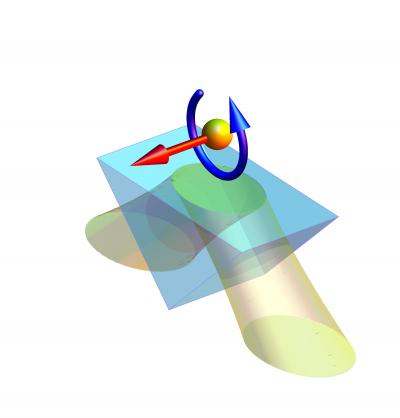Extraordinary momentum and spin discovered in evanescent light waves

Transverse force and torque on a particle in evanescent field generated from a total internal reflection in a glass prism. These reveal the presence of the transverse momentum and spin in the evanescent wave above the prism. Credit: RIKEN
The study carried out in the Quantum Condensed Matter Research Group (CEMS, RIKEN, Japan) led by Dr. Franco Nori is published today in the journal Nature Communications.
Energy, momentum, and angular momentum are the main dynamic characteristics of physical objects. It is well known that light propagating as an electromagnetic wave or photon carries momentum along the direction of the wave's propagation, and that this momentum is independent of polarization. In addition, light can carry an intrinsic angular momentum, called spin, that is proportional to the degree of circular polarization (helicity), and aligned with the propagation direction.
The RIKEN team analysed the momentum and spin of evanescent electromagnetic waves – a type of light waves that travel close to the surface of material objects and whose intensity decreases exponentially, rather than varying sinusoidally, from the interface where they were formed.
Surprisingly, the researchers found that evanescent waves carry momentum and spin components that are orthogonal to the direction of wave propagation. Moreover, the transverse spin turns out to be independent of polarization and helicity, while the transverse momentum is proportional to the wave helicity.
“Such extraordinary properties, revealed in very basic objects, offer a unique opportunity to investigate and observe fundamental physical features, which were previously hidden in usual propagating light and were considered impossible,” says Dr. Konstantin Bliokh, first author of the study. “In addition to a detailed theoretical analysis, we propose and simulate numerically four novel experiments for the detection of the unusual momentum and spin properties of evanescent waves via their interaction with small probe particles,” he adds.
These results add a new chapter to the physics of momentum and spin of classical and quantum fields, and predict a number of novel light-matter interaction effects involving evanescent waves.
For more information please contact:
Juliette Savin
RIKEN
Tel: +81-(0)48-462-1225
Mobile phone: +81-(0)80-8895-2136
Email: pr@riken.jp
Reference:
Extraordinary momentum and spin in evanescent waves
Konstantin Y. Bliokh, Aleksandr Y. Bekshaev, Franco Nori
Nature Communications, 2014 DOI: 10.1038/ncomms4300
About RIKEN
RIKEN is Japan's largest research institute for basic and applied research. Over 2500 papers by RIKEN researchers are published every year in leading scientific and technology journals covering a broad spectrum of disciplines including physics, chemistry, biology, engineering, and medical science. RIKEN's research environment and strong emphasis on interdisciplinary collaboration and globalization has earned a worldwide reputation for scientific excellence.
Website: http://www.riken.jp/en/
Find us on Twitter at @riken_en
About the Center for Emergent Matter Science
The aim of the research carried out at the Center for Emergent Matter Science (CEMS) is to address humanity's energy problems and contribute to building a sustainable society. Taking a pioneering role in the new field of emergent materials science, scientists at CEMS are developing new, more efficient technologies that will enable us to produce energy without putting a burden on the environment, as well as decrease our energy consumption. They achieve this by combining advanced research in physics, chemistry and electronics in order to produce new technology such as highly efficient energy conversion devices and low-consumption electronics.
Website: http://www.cems.riken.jp/en/
Media Contact
All latest news from the category: Physics and Astronomy
This area deals with the fundamental laws and building blocks of nature and how they interact, the properties and the behavior of matter, and research into space and time and their structures.
innovations-report provides in-depth reports and articles on subjects such as astrophysics, laser technologies, nuclear, quantum, particle and solid-state physics, nanotechnologies, planetary research and findings (Mars, Venus) and developments related to the Hubble Telescope.
Newest articles

Properties of new materials for microchips
… can now be measured well. Reseachers of Delft University of Technology demonstrated measuring performance properties of ultrathin silicon membranes. Making ever smaller and more powerful chips requires new ultrathin…

Floating solar’s potential
… to support sustainable development by addressing climate, water, and energy goals holistically. A new study published this week in Nature Energy raises the potential for floating solar photovoltaics (FPV)…

Skyrmions move at record speeds
… a step towards the computing of the future. An international research team led by scientists from the CNRS1 has discovered that the magnetic nanobubbles2 known as skyrmions can be…





















